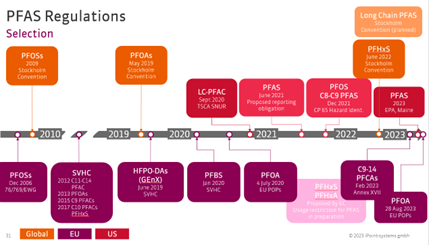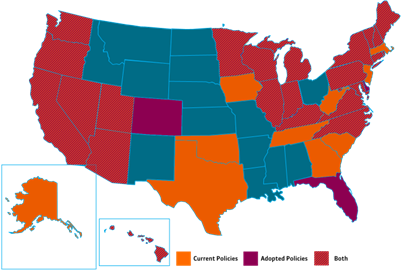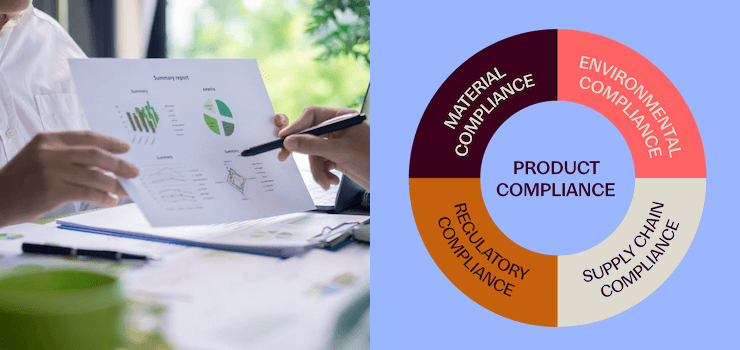PFAS, or Per- and Polyfluoroalkyl Substances, have become a significant global concern due to their prevalence and potential health and environmental impacts. In this blog article, we will delve into the latest updates on PFAS legislation, focusing on developments in Europe and North America and their impact on manufacturing companies.
What are Per- and Polyfluoroalkyl Substances (PFAS)?
PFAS is a group of human-made aliphatic organic chemical compounds used in a variety of products for their water- and grease-resistant properties. The group includes over 10,000 substances such as PFOS (perfluorooctane sulfonic acid), PFOA (perfluorooctanoic acid), perfluorononanoic acid (PFNA) and perfluorohexane sulfonic acid (PFHxS). As they or their degradation products are very persistent in the environment, they are also known as persistent organic pollutants or "forever chemicals".
The Economic Role of PFAS
PFAS play a major role for manufacturing companies. Due to their water, grease and dirt-repellent as well as heat-resistant properties, PFAS are used in numerous everyday products:
- Non-stick cookware
- Fire-fighting foam
- Food packaging
- Rain jackets and water resistant clothes
- Waxes and lubricants (e.g. in ski waxes)
- Electronic devices & cable sheaths
- And many more

Picture: PFAS Usage and Emissions Overview
Source: ECHA, “Consultation on restriction proposal for per- and polyfluoroalkyl substances (PFAS). https://echa.europa.eu
Health and Environmental Effects
Per- and Poly-fluoroalkyl Substances have garnered increased attention in recent years due to their impact on health, water, and the environment.
Health Concerns
Research has raised concerns about the potential health effects of PFAS exposure and contact to PFAS-containing products. These chemicals have been associated with various health issues, including reproductive problems, cancer, and adverse effects on the immune system.
Environmental Impacts
PFAS contamination in water sources has become a significant environmental challenge. These substances do not break down easily, leading to long-term pollution. Consequently, groundwater and even our drinking water may contain traces of PFAS, posing potential risks for humans as well as wildlife, in particular mammals. Research data shows that also air can be contaminated with PFAS through various sources. One significant pathway is the release of PFAS-containing particles into the air from manufacturing facilities, where these chemicals are used. Additionally, PFAS can be emitted into the air through the use of PFAS-containing products, e. g. certain types of firefighting foam.
National and International Regulations on PFAS
In response to the growing concern, regulatory agencies such as the Environmental Protection Agency (EPA) and the Food and Drug Administration (FDA) on the US side and the European Commission and ECHA on the European side have initiated programs and systems to assess PFAS levels and regulate PFAS in various products and environments. These measures are aimed at ensuring consumer safety and protecting public health.

Picture 2: Evoluton of PFAS Regulations - it illustrates the increasing frequency and broadening scope of PFAS regulations over the years. What began with clear regulations for specific groups has expanded to cover a wider range of substances.
Source: ECHA, “Consultation on restriction proposal for per- and polyfluoroalkyl substances (PFAS). https://echa.europa.eu
United States Regulations & Legislations
On a federal level in the United States, the EPA issued a final rule for PFAS under TSCA section 8 (a) 7 (Toxic Substances Control Act). This rule applies to manufacturers and importers of all PFAS and PFAS-containing articles, requiring reporting dating back to January 2011. The reporting, due within 18 months of the rule's effective date, encompasses uses, production volumes, disposal, exposure, and hazards.
Different states have taken various approaches to address PFAS contamination. State-level regulations in the US are also gaining momentum, with various states implementing rules to phase out PFAS in different products, including food packaging, carpets, rocks, aftermarket products, and firefighting foams.
Regional Legislation in Maine and Minnesota: Maine and Minnesota have introduced significant legislation with reporting requirements for all intentionally added PFAS. Despite initial plans to start in 2023, Maine faced industry pushback, resulting in a prohibition of sales starting January 1, 2030, unless PFAS use is deemed unavoidably necessary by the authorities.

Picture3: State-level PFAS Regulation US.
Source: https://www.saferstates.com/toxic-chemicals/pfas/
European Regulations
In Europe, a broad new PFAS restriction proposal aims to prohibit the manufacturing, marketing, and use of PFAS in mixtures or articles, including imports. Thresholds are currently set low, due to feedback collected through a standard procedure by the EU primarily consisted of inquiries from the industry. These inquiries often included references to applications where PFAS (per- and polyfluoroalkyl substances) are challenging to replace. Additionally, there were inquiries about potential exceptions to the proposed regulations, indicating a concern for specific cases where alternatives to PFAS may be limited.
The restriction of the entire group of PFAS in the EU chemicals regulation REACH (Regulation (EC) No. 1907/2006) is part of this package of measures.
The manufacture, import, placing on the market and use of perfluoroalkyl and polyfluoroalkyl substances are to be banned. A six-month public consultation started on March 22, 2023. During this time, information could be submitted to justify the inclusion of further exemptions in the restriction proposal, for example. ECHA's scientific committees is evaluating this information when preparing their opinion.

Picture 4: Overview of European PFAS Restriction Proposal.
Source: ECHA
The figure outlines the proposed restrictions in Europe, emphasizing the low thresholds in the ppm to ppb range.
The European restriction proposal contemplates two options: a full ban with an 18-month transition period or a ban with specific derogations. Derogations may vary from 5 to 12 years, with only a few unlimited derogations. The impact of these options is expected to be significant, requiring assessments by committees within specific timeframes.

Picture 5: Options Discussed in the European PFAS Restriction Proposal
Impact and Challenges for Companies
As the global community grapples with the challenges posed by PFAS, staying informed about the evolving legislation is crucial. The proposed regulations in Europe and North America reflect a growing awareness of the potential risks associated with PFAS, emphasizing the need for proactive measures.
Current and future PFAS regulations present producers with a variety of challenges and certain risks. This affects both the operational business and the product design. Replacement materials must be found and procured, certain products must be redesigned and recertified or, in the worst case, withdrawn from the market. In addition, most of the regulations also oblige manufacturers to register and report the substances used in their products or to disclose them to their customers.
Mitigate Risks with iPoint's Compliance Solutions
iPoint is committed to supporting stakeholders by taking action providing comprehensive insights into the list of chemicals and assisting in navigating the complexities of emerging legislations. PFAS may be complex, but their implications on health and the environment are real. By staying informed and supporting efforts for safer alternatives, we can collectively work towards minimizing the impact of PFAS on our lives and future generations.
For more detailed information and updates, you can reach out to our iPoint Experts and rely on our comprehensive compliance solutions, which are regularly updated to give you an automated and fast reliability in reporting such substances. With iPoint Compliance - our product compliance software , we offer the right solution for you and your company to manage the upcoming challenges with PFAS Compliance already today





.png)
